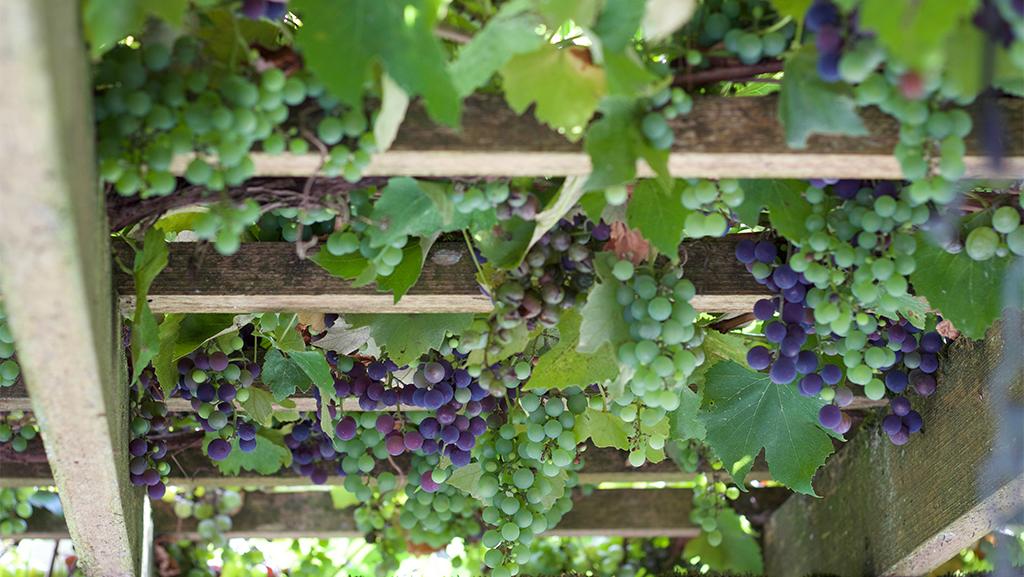Grapevine Grace: A Guide to Growing And Training Grapevines offers practical tips for cultivating healthy grapevines. Learn essential techniques for pruning, watering, and pest control.
Growing grapevines can be a rewarding experience for gardeners and winemakers. This guide provides essential knowledge to help you cultivate and maintain healthy grapevines. From selecting the right variety to understanding soil requirements, each step is crucial for success. Training your grapevines properly ensures a bountiful harvest and longevity.
Effective pruning, watering, and pest control are fundamental practices. This comprehensive guide simplifies grapevine care, making it accessible for both beginners and experienced growers. Start your journey to producing delicious grapes or exquisite homemade wine today with these expert tips.

Credit: www.monrovia.com
Introduction To Grapevine Growing
Grapevines are more than just plants; they are a part of history and culture. Growing grapevines can be a rewarding hobby or a profitable business. Whether you are a beginner or an expert, understanding the basics is crucial.
Historical Background
Grapevines have been cultivated for thousands of years. Ancient Egyptians and Romans grew grapevines for wine and food. Archaeological evidence shows grape cultivation as early as 6000 BC. These plants have been integral to human civilization.
Importance Of Grapevines
Grapevines hold immense importance in agriculture and culture. They produce grapes used in wine, juice, and food. The wine industry relies heavily on grapevines, contributing billions to the economy. Grapevines also provide aesthetic value to gardens and landscapes.
Growing grapevines offers many benefits:
- Fresh fruit for your family
- Potential income from grape products
- Beautiful addition to gardens
| Benefit | Description |
|---|---|
| Health | Grapes are rich in vitamins and antioxidants. |
| Economic | Wine production and grape sales boost the economy. |
| Cultural | Grapes are symbolic in many traditions and rituals. |
Choosing The Right Grape Varieties
Choosing the right grape varieties is essential for successful grapevine growth. Different grapes thrive in different climates and soils. This guide helps you make informed choices.
Climate Considerations
The climate plays a crucial role in grapevine success. Grapevines need specific temperatures and sunlight to grow well.
- Cool Climates: Prefer varieties like Riesling and Pinot Noir.
- Warm Climates: Choose grapes such as Cabernet Sauvignon and Zinfandel.
- Hot Climates: Opt for grapes like Shiraz and Grenache.
Ensure your region’s climate matches the grape variety’s needs.
Soil Requirements
Soil quality affects grapevine health and fruit quality. Different grape varieties have different soil preferences.
| Grape Variety | Preferred Soil |
|---|---|
| Chardonnay | Well-drained clay or limestone |
| Merlot | Loamy and slightly acidic |
| Sauvignon Blanc | Gravelly and well-drained |
Test your soil to ensure it’s suitable for your chosen grape variety. Healthy soil promotes strong growth and high-quality grapes.
Preparing The Vineyard
Growing healthy grapevines begins with preparing the vineyard properly. This involves selecting the right site and preparing the soil. Each step is crucial for a thriving grapevine. Let’s break down these steps under the following headings.
Site Selection
Choosing the right location is vital. Grapevines need plenty of sunlight. Aim for at least 6-8 hours of sun each day. Avoid areas with heavy shade. The site should have good air circulation to prevent diseases.
Consider the slope of the land. A gentle slope helps with water drainage. Grapevines do not like waterlogged soil. Avoid low-lying areas where water collects. Elevation can also impact temperature. Higher elevations tend to be cooler.
| Factor | Ideal Condition |
|---|---|
| Sunlight | 6-8 hours daily |
| Air Circulation | Good |
| Land Slope | Gentle slope |
| Elevation | Higher is cooler |
Soil Preparation
Healthy soil is the foundation of a strong vineyard. Start by testing the soil pH. Grapevines prefer a pH of 5.5 to 6.5. Adjust the pH if needed. Add lime to increase pH or sulfur to lower it.
Next, ensure the soil has good drainage. Dig a hole and fill it with water. If it drains within 24 hours, it’s good. If not, consider amending the soil with organic matter.
- Test soil pH
- Adjust pH to 5.5-6.5
- Check for drainage
- Add organic matter
Proper soil nutrition is also key. Add compost to enrich the soil. You might also need to add fertilizers. A balanced fertilizer with nitrogen, phosphorus, and potassium works well.
By carefully selecting your site and preparing the soil, you set the stage for a productive vineyard. Happy planting!
Planting Grapevines
Planting grapevines is the first step to a thriving vineyard. Whether you’re growing grapes for wine or fresh fruit, proper planting is crucial. This guide will walk you through the best techniques, spacing, and layout for a successful grapevine plantation.
Planting Techniques
To start, choose a sunny location with well-draining soil. Grapevines love sunlight and need at least 6 hours of direct sun daily.
- Dig a hole: Make it twice as wide as the root ball.
- Prepare the soil: Mix compost with the soil to enrich it.
- Plant the vine: Place it in the hole, spreading roots evenly.
- Cover the roots: Fill the hole with soil, pressing down lightly.
- Water well: Give the plant a deep watering to settle the soil.
Spacing And Layout
Proper spacing is vital for healthy grapevines. It ensures each vine gets enough nutrients and sunlight.
| Vine Type | Spacing Between Vines | Row Spacing |
|---|---|---|
| Table Grapes | 6-8 feet | 9-10 feet |
| Wine Grapes | 5-6 feet | 8-9 feet |
Arrange vines in rows running north to south. This layout maximizes sun exposure.
Use trellises or stakes for support as vines grow. This keeps them off the ground and helps air circulation.
Training Systems
Training grapevines involves guiding their growth for better fruit production. Proper training ensures healthy plants and abundant harvests. In this guide, we explore various training systems for your grapevines.
Trellising Methods
Trellising methods support the vines and expose them to sunlight. Here are some popular trellising methods:
- Vertical Shoot Positioning (VSP): This method uses a single wire to guide the growth. Vines grow vertically, making it easy to manage and prune.
- Geneva Double Curtain (GDC): This system uses two wires, creating a curtain effect. It’s ideal for high-vigor vines.
- Lyre System: Similar to GDC, but with a wider spacing. It allows more sunlight to penetrate the canopy.
Pruning Techniques
Pruning techniques are crucial for vine health and fruit quality. Here are some effective pruning techniques:
- Cane Pruning: Remove old wood and retain new canes. This method promotes new growth.
- Spur Pruning: Retain short spurs from the main trunk. It’s simple and effective for many grape varieties.
- Head Training: No trellis needed. It’s ideal for backyard growers with limited space.
Remember to prune during the dormant season for best results.
| Method | Best For | Advantages |
|---|---|---|
| VSP | Low to medium vigor vines | Easy to manage |
| GDC | High vigor vines | Good sunlight exposure |
| Lyre | Wide canopies | Excellent airflow |
Watering And Fertilizing
Proper watering and fertilizing are crucial for healthy grapevines. These practices ensure robust growth and a bountiful harvest. This guide covers effective strategies for irrigation and nutrient management.
Irrigation Strategies
Grapevines need consistent moisture, especially during the growing season. Here are some effective irrigation strategies:
- Drip irrigation: Delivers water directly to the roots, minimizing waste.
- Soaker hoses: Distribute water evenly and reduce evaporation.
- Mulching: Helps retain soil moisture and suppresses weeds.
Water grapevines early in the morning. This reduces evaporation and helps prevent fungal diseases. Avoid overhead watering to keep leaves dry and healthy.
Nutrient Management
Grapevines need a balanced diet of nutrients to thrive. Follow these nutrient management tips:
| Essential Nutrient | Function | Signs of Deficiency |
|---|---|---|
| Nitrogen (N) | Promotes leaf and stem growth | Yellowing leaves |
| Phosphorus (P) | Encourages root development | Poor root growth |
| Potassium (K) | Enhances fruit quality | Weak stems |
Apply a balanced fertilizer in early spring. Use compost to improve soil structure and add organic matter. Monitor soil pH levels to ensure nutrient availability. Keep soil pH between 5.5 and 7.0 for best results.
Pest And Disease Control
Keeping your grapevines healthy requires diligent pest and disease control. This ensures a bountiful harvest and robust growth. Below are methods to protect your grapevines from common pests and diseases.
Common Pests
Grapevines attract various pests that can harm your crop. Here are some common pests to watch for:
- Grape Berry Moth: This moth lays eggs on grape clusters. Larvae feed on the berries.
- Leafhoppers: These small insects suck sap from leaves. They cause yellowing and reduce photosynthesis.
- Spider Mites: These tiny pests create webs on leaves. They cause stippling and leaf drop.
- Japanese Beetles: These beetles chew on leaves, leaving skeletonized foliage.
| Pest | Damage | Control Method |
|---|---|---|
| Grape Berry Moth | Damage to berries | Use pheromone traps |
| Leafhoppers | Yellowing leaves | Apply insecticidal soap |
| Spider Mites | Stippling on leaves | Increase humidity |
| Japanese Beetles | Chewed leaves | Handpick beetles |
Disease Prevention
Preventing disease is crucial for healthy grapevines. Follow these practices:
- Pruning: Remove diseased and dead wood. This improves air circulation.
- Sanitation: Clean up fallen leaves and debris. This reduces disease spread.
- Watering: Water at the base of the plant. Avoid wetting the foliage.
- Fungicide: Apply fungicides during wet seasons. This helps prevent fungal diseases.
Common grapevine diseases include:
- Downy Mildew: Causes yellow spots on leaves. Apply copper-based fungicides.
- Powdery Mildew: Leaves get a white powdery coating. Use sulfur-based sprays.
- Botrytis Bunch Rot: Affects grapes in humid weather. Ensure good air circulation.
- Black Rot: Causes dark spots on leaves and fruit. Remove affected parts.

Credit: www.researchgate.net
Harvesting And Post-harvest Care
Grapevine Grace offers a comprehensive guide to growing and training grapevines. An essential part of this journey is the harvesting and post-harvest care of your grapevines. Proper harvesting ensures the best quality of grapes. Post-harvest care maintains the longevity and taste of your produce.
Optimal Harvest Time
Choosing the right time to harvest is crucial. Grapes should be picked at peak ripeness. This usually happens in late summer to early fall. Check for color changes and taste. Grapes should be sweet and juicy.
- Check the sugar levels using a refractometer.
- Harvest in the early morning for best results.
- Avoid harvesting in wet conditions to prevent mold.
Storage And Processing
Once harvested, grapes need proper storage and processing. This keeps them fresh and tasty. Follow these steps for optimal results:
- Sort the grapes to remove damaged ones.
- Rinse the grapes gently to clean them.
- Store in a cool, dry place to maintain freshness.
For longer storage, consider these methods:
| Method | Details |
|---|---|
| Refrigeration | Store at 32°F (0°C) for up to 2 weeks. |
| Freezing | Freeze in airtight containers for up to 6 months. |
| Drying | Dry grapes to make raisins. Store in airtight containers. |
Proper post-harvest care ensures your grapes remain delicious. Follow these guidelines for the best results.

Credit: www.gurneys.com
Frequently Asked Questions
How Do You Start Growing Grapevines?
To start growing grapevines, choose a sunny location with well-draining soil. Plant dormant vines in early spring. Space them 6-10 feet apart. Water regularly.
What Is The Best Soil For Grapevines?
Grapevines thrive in well-draining, loamy soil with a pH of 5. 5-7. 0. Avoid heavy clay soil. Amend soil with organic matter.
How Often Should You Water Grapevines?
Water young grapevines weekly to establish roots. Mature grapevines need deep watering every 2-3 weeks, especially in dry periods.
When Should Grapevines Be Pruned?
Prune grapevines in late winter or early spring before new growth begins. Remove dead, damaged, or weak canes.
Conclusion
Cultivating grapevines can be rewarding and enjoyable. Follow these tips for healthy, thriving plants. Remember to prune regularly for best results. With patience and care, you’ll enjoy a bountiful harvest. Happy gardening and may your vines flourish!


